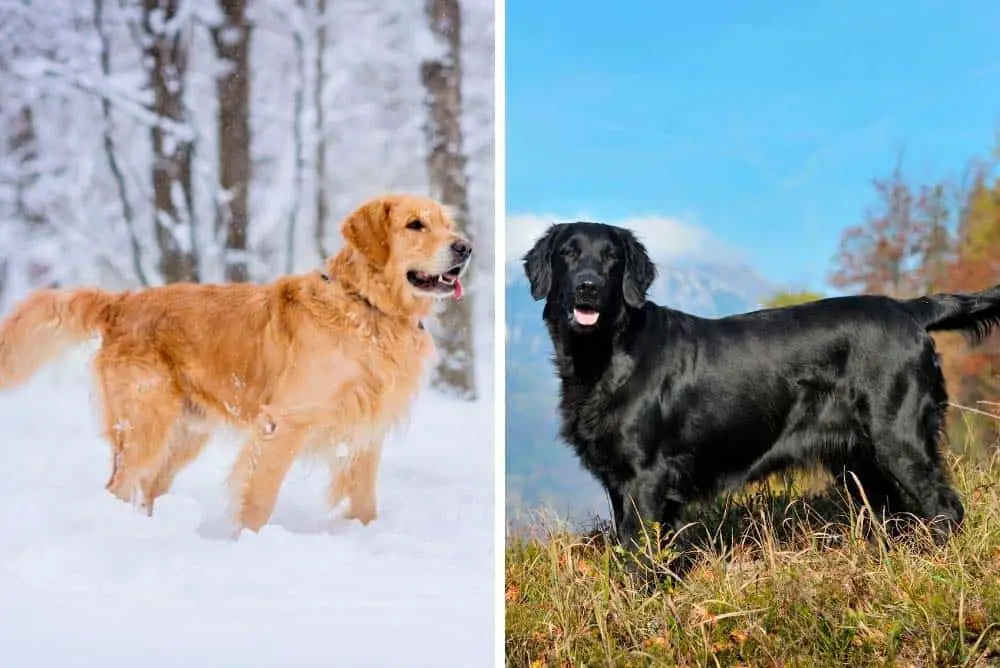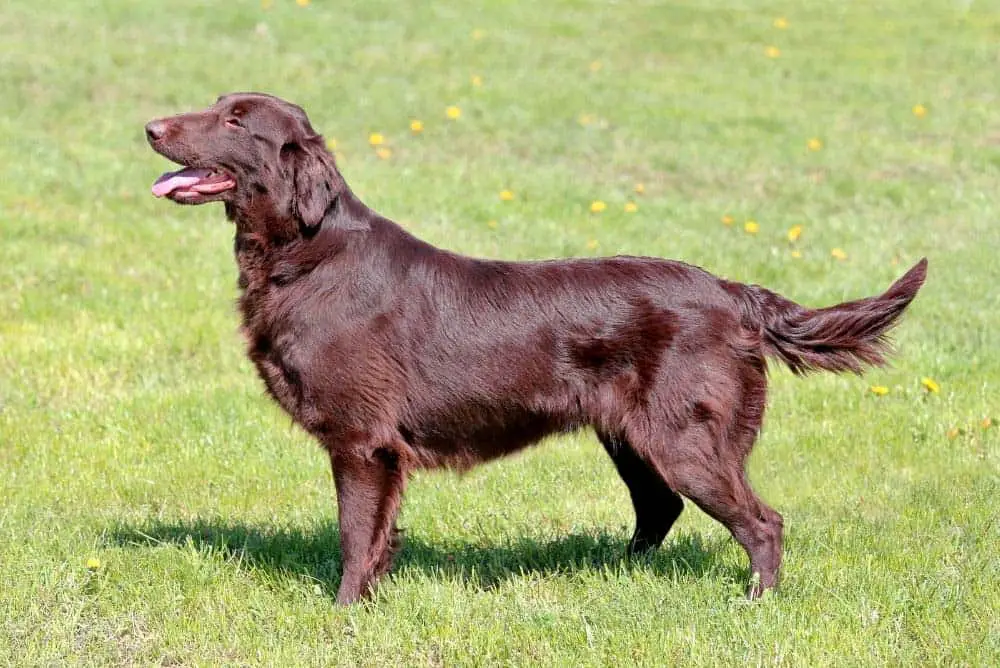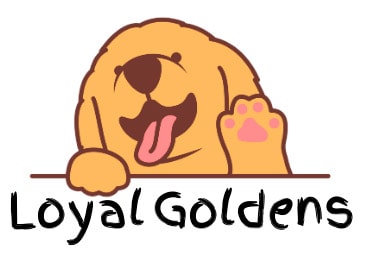Any breed of retriever is a great choice for a family pet! Retrievers are popular because they’re beautiful, fun, loving, and gentle dogs. Most people know the difference between a Golden and a Labrador retriever, but what’s the difference between a Golden Retriever and a Flat-Coated Retriever?
The main difference between these two dogs is their coat. A Golden retriever is an iconic yellow to reddish colored dog, with wavy fur, while the Flat-Coated retriever is black or liver colored, with a shiny coat that lays flat. These two breeds can vary in both color and feathering in their coats.
These two dogs are similar in many ways but have a couple of big differences that aren’t just cosmetic. To find out all the similarities and differences, as well as the history of the breeds, keep reading.

(This article may contain affiliate links and loyalgoldens may earn a commission if a purchase is made.)
Unlock your goldens natural intelligence and see just how quickly problem behaviors disappear.This is the best at home dog training I've ever used!
Breed History
These two breeds of retrievers are more similar than different. In fact, they are cousins and descend from the same areas in the United Kingdom. They were both bred to be working dogs and are classified in the Sporting breed group of the American Kennel Club. Descended from hunting dogs, these two retrievers are active, loyal, and make great family companions.
Golden Retriever
The Golden retriever breed originated in Scotland, where a well-known dog breeder, Lord Tweedmouth, was mating spaniels and retrievers in the mid to late 1800s. His goal was to create a retriever that was a great hunting dog, who could stay focused, take commands better than a spaniel, and be well-mannered in the house.
After mating a Wavy-coated retriever to a Tweed Water Spaniel, Lord Tweedmouth had a litter that contained three yellow, wavy coated puppies. He kept these three puppies and gave the others away to friends. The three yellow puppies were mated to another Tweed Water Spaniel and a Red Setter. He continued to mate only the yellow dogs and this began the Golden retriever line.
The Golden retriever as a breed was recognized by the Kennel Club of England in 1911, and then by the AKC in 1932.
Flat-Coat Retriever
The Flat-Coated retriever breed came about in the same fashion as the Golden retriever. S.E. Shirley, the founder of the British Kennel Club, wanted a retriever with a flatter coat and a dog with more refined features. The retrievers and Labradors out of Newfoundland were boxy and rugged, and Shirley was looking for something a bit different.
Shirley bred black wavy-coated retrievers to collies (assumed) to help flatten the coat and lengthen the face. He wanted a dual-purpose dog, meaning a dog who was useful for hunting and refined enough to show.
The breed almost faced extinction when the popularity of Golden retrievers and Labradors grew. In 1960 the Flat-Coated Retriever Society of America formed to help save the breed. The official breed recognition in the AKC came about in 1915 as the club’s 73rd official breed.
Physical Differences: Golden Retriever vs. Flat-Coated Retriever
Both Golden retrievers and Flat-Coated retrievers are of a similar size and weight. The physical differences between the two breeds comes down to color, coat texture, and head shape.
Color
Right off the bat, you’ll notice these dogs are opposite colors. This is how you’ll always be able to tell them apart. You can’t mix them up if you understand the basic coat coloring of the two dogs and that purebreds within both breeds fall within a variant of their respective colors.
As its name states, the Golden is a golden or yellow color ranging from a light yellow or a golden red. Golden retrievers are sometimes confused with the yellow Labradors for being similar in color.
While the Golden retriever comes in many shades, the golden yellow color is the most prevalent and found in households all over the UK and the United States.

The Flat-Coated retriever is generally black but can range up to a brown/red color described as liver-colored. A black colored dog is the least popular color of any breed of dog, as it has origins in superstition (like a black cat), making the much rarer liver-colored variety in high demand.
If you love a black dog, however, then the Flat-Coated retriever is a great choice to consider.
Coat
The texture of the coat differs slightly for these two breeds as well. They differ in the wave of the fur, where on their body the hair feathers, and the amount of hair. Both are moderate shedders and will need to be brushed regularly.
The Flat-Coated retriever has a coat that… well lays flat. It has much less wave but does have feathering around the legs, ears, chest, and tail. The fur on the Flat-Coats is shiny and longer than the Golden retriever. This breeds coat is designed to keep the dog warm in cold weather and when in water.
The Golden retriever has a beautiful double coat to keep them warm as well, and their hair has a bit more wave or feathering. The amount of wave can vary from straight to a heavy wave. You can find the feathering of the coat pretty much all over, and you might also find it all over your couch 🙂 The Golden sheds a bit more than the Flat-Coat, especially in the spring and fall.
Face Shape
The last major physical difference between the Golden and Flat-Coated retriever is the head. The face shape of these dogs is noticeably different. The Flat-Coated retriever is a descendant (rumored) of a Collie and this could be where the slender face comes from. A more pointed face gives the dog a more sophisticated look.
The Golden has the classic retriever head, which is more box-like and robust. While not as robust as the Labrador retriever, it’s not slender like the Flat-Coat. The wider face has not slowed down the breed’s popularity and may be preferred by most Americans.
Temperament Differences: Golden vs Flat-Coated Retriever
Both of these breeds are great family dogs because their temperaments are friendly and loving. In general, they are not aggressive dogs, but they do differ somewhat in energy level.
The Flat-Coated retriever is considered a “forever puppy”, meaning they never lose their energy. They are highly energetic dogs that need lots of exercise (about 90 minutes) a day. Because of the breed’s energy and excitement level, they will be more into jumping up on people than the Golden retriever.
The Flat-Coated retriever is also a much more independent dog breed. They don’t need human attention or presence all the time. The Golden is more susceptible to anxiety when left alone for long periods of time.
The Golden retriever is a high energy dog as well, but can also display a calmer personality if the household is calm. This quality is part of what makes them more popular than the Flat-Coat. The Golden needs a little less exercise of about 30 minutes of vigorous ball fetching twice a day.
It’s important to know that each dog breed has an active lifestyle designed for the outdoors. The retriever breeds thrive in active households and neither do well in apartment environments. To take on a retriever breed is an undertaking, and should be fully considered before diving in.
Popularity Differences: Flat-Coated vs. Golden Retrievers
The Golden retriever and the Labrador retriever are the two most popular retrievers, according to the American Kennel Club (AKC). Their personalities make them great family dogs, companions, and good hunting dogs. The Flat-Coated retriever has many of the same qualities, but their higher energy and less desirable color land them further down the popularity list.
The Golden retriever is ranked the third most popular dog in the United States and is described as intelligent, friendly, and devoted. The Golden retriever may also be more popular than the Flat-Coated retriever because they have a longer life expectancy and are generally a calmer breed.
The Flat-Coated retriever is ranked as the 91st most popular dog breed by the AKC. They’re not the least popular retriever in the United States; but the higher energy level, longer hair, color, and shorter life expectancy (more on that below) gives them a disadvantage.
Discover how to train your Golden Retriever by playing games: 21 games to play with your Golden that will make them smarter and better behaved!
Care Needs of Golden and Flat-Coated Retrievers
Exercise and Play
Both the Flat-Coat and Golden were created to be active sport dogs, and so they need regular exercise. The Flat-Coated being slightly more energetic, needs a bit more concentrated play. Both dogs like to chase, run, hike, and swim. When at home, it’s a good idea to have balls or toys to keep their mouths occupied.
The Flat-Coated retriever requires 90 minutes of active play or exercise daily and is a great dog for families who live in the country. They take well to training and are good running companions once full-grown. It’s important to remember puppies’ bones are still growing, and too much activity, when little, will lead to joint problems.
(You can find out more about running with your retriever in our article: Running With Your Golden Retriever: What You Need to Know)
The Golden retriever needs about 60 minutes of active play/exercise daily to help keep them calm at home. Any retriever that isn’t exercised regularly will develop behavior problems, such as chewing up your favorite shoes. As in the Flat-Coat, be careful with exercise when young. Keep off hard concrete surfaces, and keep play to grassy areas.
The Right Diet
The food requirements for each breed are similar. Because the Flat-Coated has more energy and burns more calories, they will need slightly more food. Make sure you’re reading the instruction labels on the food you buy. Each dog will need a different amount based on its age and size.
Higher quality food will have a smaller serving because it’s full of protein. Lower quality food is mostly corn and filler and won’t keep your dog full for as long.
A high quality food such as Blue Buffalo Wilderness High Protein (amazon) will give your dog the nutrition that it needs to be healthy and happy.
The Flat-Coated needs roughly 3.5-4.5 cups of dry kibble each day. This should be divided into 2 separate servings. It’s not recommended to leave food out for a retriever because they will overeat when bored.
Note: A warning about the Flat-Coat is their tendency to eat their own poop. To avoid this, you should pick up the poop in your yard at once.
The Golden retriever needs 2 to 3 cups a day, also divided into 2 separate meals. It’s recommended not to overfeed a golden puppy. They grow quickly between the ages of 4 months to 7 months, and overfeeding them will speed up growth, leading to hip and joint problems.
Lifespan: Golden Retriever & Flat-Coated Retriever
The larger size of these breeds means they take longer to reach full size and maturity. The growth rate for these dogs is 1-2 years, taking a little longer in the Flat-Coated. The Golden grows very quickly as a puppy and will reach its full height at 1 year, and full weight at 2 years.
A Golden retriever will get as large as 75 lbs. and up to 24 inches tall in males.
The Flat-Coated retriever is slightly taller at 24.5 inches being the tallest, and up to 70 lbs. for males.
The general rule for dogs is the larger the dog, the shorter the lifespan. Both the Golden and Flat-Coated retrievers are medium to large dogs. The average life expectancy for both breeds is 10 years, although the Flat-Coated don’t generally live as long as Goldens.
| Breed | Life Expectancy |
|---|---|
| Golden Retriever | 10 – 12 years |
| Flat-Coated Retriever | 8 – 10 years |
Common Ailments
All dogs will have common health problems specific to their breeds. The Flat-Coated and Golden are not different. Both retrievers are well-known for having hip and joint problems. Golden retrievers are screened for more issues than the Flat-Coated, but a responsible breeder should be able to show you the health and genetic screenings for their dogs.
Golden Retriever Health Issues
The Golden retriever has common elbow and hip dysplasia problems due to their rapid growth. Other common health concerns include cataracts, pigmentary uveitis, retinal atrophy, and subvalvular aortic stenosis.
The Golden is also susceptible to epileptic seizures, hypothyroidism, allergies, and Von Willebrand’s Disease.
The recommended health tests you should make sure the breeder conducts are:
- Hip Evaluation
- Elbow Evaluation
- Cardiac Exam
- Ophthalmologist Evaluation
- Neuronal Ceroid Lipofuscinosis 10 or NCL10
Flat-Coated Retriever Health Issues
In addition to screening for possible major health problems, the retriever breeds should have their ears and teeth cleaned regularly. A retriever is prone to infections in the ears (read our article here to find out how to take care of your retrievers ears) and tooth decay.
The health issues for a Flat-Coat are like that of a Golden and include hip dysplasia, knee dysplasia, and eye problems.
This breed has a higher cancer rate than the golden retriever, and the most common cancer is malignant histiocytosis. Other cancers include lymphosarcoma, hemangiosarcoma, and osteosarcoma.
The recommended health tests for a Flat-Coated retriever are:
- Hip Evaluation
- Patella Evaluation
- Ophthalmologist Evaluation
Deciding on Getting a Retriever Dog
If you’re trying to decide if you want to add a retriever to your family and are interested in both of these breeds, here are some questions to help you decide between the two.
- How much free time do you have? It’s important to have a good amount of free time if you want a retriever. Retrievers are active sporting dogs who need regular and vigorous exercise. You’ll need time for walks, playing fetch, runs, hunting, or swimming. The Flat-Coat requires even a bit more activity than the Golden. If you have free but limited time, consider the Golden over the Flat-Coat.
- What reasons do you want a retriever? Take time to think about the reason you want a dog and the reasons you want a retriever. If you’re looking for a calm family dog that’s easy to train and gentle with children, then go with the Golden retriever. If you like to go hunting often or are a regular hiker, a Flat-Coat will work well in your household.
- Do you have a color preference? This question is pretty simple. If you really want a yellow or golden dog, consider a Golden retriever. If you are passionate about darker colored dogs, a Flat-Coat will be great! Neither breed is available in the other color, so your choice will be simple if you have a color preference.
- How hard do you want to look for a dog? The Golden retriever is the 3rd most popular breed in America, and finding a Golden Retriever won’t be difficult. The Flat-Coat is a breed that almost went extinct in the early 1900s and isn’t as popular in America. A Flat-Coat will be much harder to find.
- Do you need a quiet dog? Some breeds tend to be more vocal than others. All dogs bark… you won’t find a dog that doesn’t bark. But the Flat-Coat does have a higher barking frequency than the Golden retriever. If you live in the city or a suburban neighborhood where you don’t want to annoy your neighbors with a barking dog, consider the Golden over the Flat-Coat.
No matter which of these two breeds you choose, you’ll get a loving, loyal, and fun dog.
Last Words
The differences between the Golden versus the Flat-Coat retriever are few. The main differences are cosmetic; meaning the color and texture of the coat, and face shape. They differ a little in energy level and life expectancy, but both will become valued and loved family members. Take the time to consider which will suit your family better, and start looking for the dog of your dreams.
Additional Breed Comparisons
- Border Collie vs. Golden Retriever (And The Best Dog Is…)
- Golden Retriever vs. Labrador Retriever (Are They the Same?)
Golden Retriever Articles You’ll Love!
- The World of Golden Retriever Coat Colors (with Pictures!)
- How to Take Care of Your Golden Retriever’s Coat: Step-by-Step
- Can a Golden Retriever and German Shepherd Live Together? (Explained!)
- Is Your Golden Retriever Lonely? (How to Tell & What to Do!)
Sources
- American Kennel Club: Compare Dog Breeds
- Doggie Designer: Flat-Coated Retriever vs Golden Retriever: Which One to Choose?
- The Clan Majoribanks Society: Lord Tweedmouth’s Golden Retrievers
- Flat-Coated Retriever Society of America: A Brief History of The Flat-Coated Retriever
- UK Kennel Club
- OFORA: Golden Retriever Pigmentary Uveitis
- VCA Hospitals: Progressive Retinal Atrophy in Dogs | VCA Animal Hospital
- MSPCA-Angell: Subaortic Stenosis
- AKC Canine Health Foundation
- VCA Hospitals: Hypothyroidism in Dogs
- VCA Hospitals: Von Willebrand’s Disease in Dogs
- AKC: Lymphoma in Dogs: Symptoms, Diagnosis, and Treatment
- VCA Hospitals: Osteosarcoma in Dogs
